To the lecture series English top page
Comments on Lecture 20 "How to Draw Impossible Figures"
Comment 1. Answer to the question"
The left figure in the first row represents a single object. Therefore, it becomes impossible if the hiding part and the hidden part are exchanged.
The feft figure in the second row, on the other hand, represents two separated objects. Therefore, when we exchange the hiding part and the hidden part, the associated objects change their depths, and the figure remains to be correct. Whether or not the figure becomes impossible depends on whether the hiding part and the hidden part belong to the same object or to different objects.
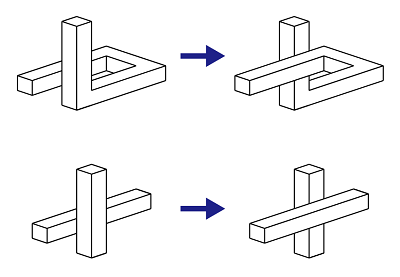
In the next example, however, we get an impossible figure when we exchange the hiding part and the hidden part. The horizontal bar has a visible left section face while the right section face is invisible. So we guess that the left part is nearer to the viewer than the right part. The resulting figure is inconsistent with this near-far relation. So it is regarded as impossible.
However, this is true if the objects are rectangular. It is not necessarily true if the objects are not rectangular. When we connect faces with arbitrary angles, the visible section face does not necessarily mean that it is nearer to the viewer. Therefore, the right figure is not impossible if we allow non-rectangular objects. In this sense the impossibility is weak when compared with the upper example.
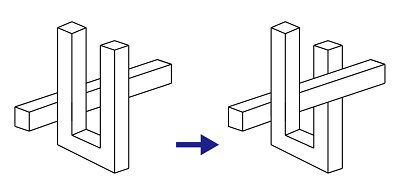
Comment 2. Reference on drawing methods for impossible figures
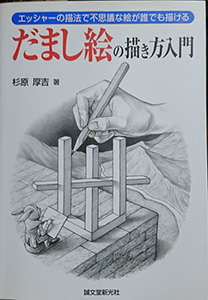 K. Sugihara, Introduction to How to Draw Impossible Figures (in Japanese), Seibundo-Shinkosha Publisher, Tokyo, 2008.
K. Sugihara, Introduction to How to Draw Impossible Figures (in Japanese), Seibundo-Shinkosha Publisher, Tokyo, 2008.
This book shows elementary techniques for drawing impossible figures. Using those techniques, anyone can draw one's original impossible figures easily.
Comment 3. Card Kit for Constructing Impossible Figures
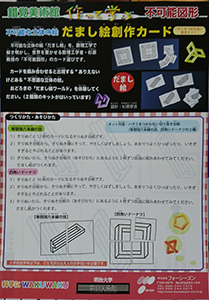 "Cards for Constructing Anomalous Pictures (Tsukutte Manabu Fukanou Zukei, Damashie Sousaku Kaado)", Four Season, Inc., Okayama, Japan.
"Cards for Constructing Anomalous Pictures (Tsukutte Manabu Fukanou Zukei, Damashie Sousaku Kaado)", Four Season, Inc., Okayama, Japan.
This is a card kit, by which we can construct impossible figures. I used those cards in my video lecture.
Comment 4. Maze book using impossible figures
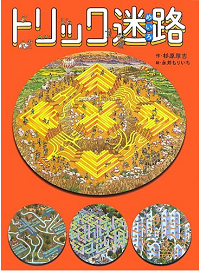 K. Sugihara and M. Nagai: Trick Mazes (in Japanese). Gentosha Publisher, Tokyo.
K. Sugihara and M. Nagai: Trick Mazes (in Japanese). Gentosha Publisher, Tokyo.
This is a maze book in which maze paths are drawn by impossible figures. As the result it contains many new tricks. For example, walking along a flat path, you may find yourself on a vertical wall and cannot walk any more.


 K. Sugihara, Introduction to How to Draw Impossible Figures (in Japanese), Seibundo-Shinkosha Publisher, Tokyo, 2008.
K. Sugihara, Introduction to How to Draw Impossible Figures (in Japanese), Seibundo-Shinkosha Publisher, Tokyo, 2008.
 "Cards for Constructing Anomalous Pictures (Tsukutte Manabu Fukanou Zukei, Damashie Sousaku Kaado)", Four Season, Inc., Okayama, Japan.
"Cards for Constructing Anomalous Pictures (Tsukutte Manabu Fukanou Zukei, Damashie Sousaku Kaado)", Four Season, Inc., Okayama, Japan.
 K. Sugihara and M. Nagai: Trick Mazes (in Japanese). Gentosha Publisher, Tokyo.
K. Sugihara and M. Nagai: Trick Mazes (in Japanese). Gentosha Publisher, Tokyo.